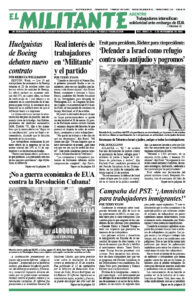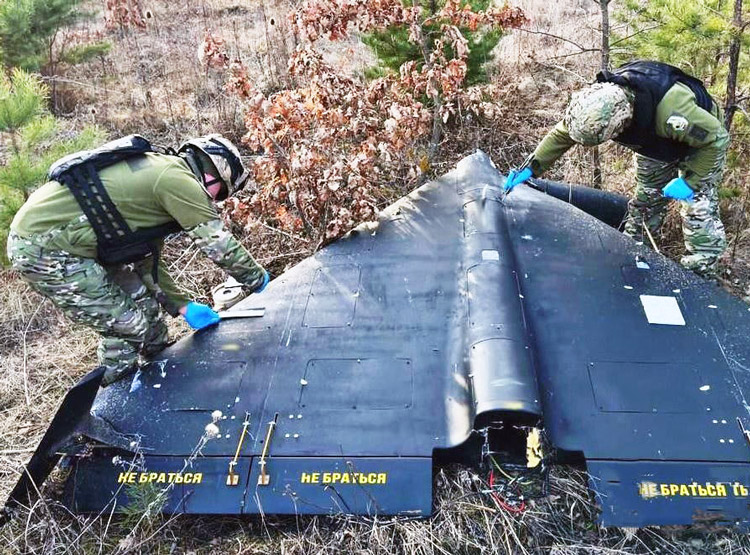Ukrainian working people are at the forefront of the fight to resist Moscow’s assault on their national sovereignty. But they also confront efforts by Washington and its allies to pressure the Ukrainian government to end its resistance. Moscow’s invasion has spawned the largest war in Europe since World War II. The U.S. rulers seek stability for their own interests in the region as they try to bolster their place at the head of the disintegrating imperialist world order.
Ukrainian President Volodymyr Zelensky wants Washington and Berlin, Ukraine’s largest arms suppliers, to lift restrictions that prevent their long-range missiles from being used to strike military targets deeper inside Russia. Zelensky also proposes Kyiv be invited to join the U.S.-led NATO military alliance.
President Joseph Biden made a one-day visit to Berlin Oct. 18 where he discussed Zelensky’s proposals with German Chancellor Olaf Scholz. They then met with French President Emmanuel Macron and U.K. Prime Minister Keir Starmer. Scholz says his government will not supply Ukraine with Taurus long-range cruise missiles.
A divergence surfaced at the meetings. Biden and Scholz oppose offering Ukraine NATO membership for now. But Macron and Starmer want to dangle future NATO membership as an incentive to try to push Kyiv into talks with Moscow.
A White House statement after the meeting only acknowledged that the four government heads had “discussed” Zelensky’s requests. The Biden administration has provided Ukraine with just enough weaponry to avoid defeat, but not enough to repel the invading forces.
The key allies of the Ukrainian toilers are working people in Russia, who also confront the deadly consequences of Putin’s war. There is growing opposition to the war among Russian soldiers and their families, and other working people.
BRICS summit in Russia
Russian President Vladimir Putin hosted a summit Oct. 22-24 of government heads from the BRICS alliance — which was founded by Brazil, Russia, India, China and South Africa — in Kazan, Russia.
Moscow and Beijing are in increasingly sharp conflict with Washington, but some other governments in the BRICS group are either neutral or U.S. allies.
Putin says the summit shows his invasion of Ukraine hasn’t isolated Moscow. Indian Prime Minister Narendra Modi attended, but told Putin he was for a “peaceful solution” to the “Russia-Ukraine problem.”
The restrictive and slow pace of weapons delivery to Ukraine by Washington and Berlin means Kyiv has to rely more on its own resources to try to blunt Putin’s invasion. Ukrainian-built missiles are now hitting targets in Russia hundreds of miles from the front.
In early October, Ukrainian drone strikes hit ammunition and missile caches inside southwestern Russia. Hundreds of Iranian-made Shahed attack drones as well as stores of glide bombs and North Korea-supplied munitions were destroyed.
Moscow sent 1,300 kamikaze drones in daily attacks on cities across Ukraine in September. Some 90% were shot down. In the three months to Aug. 31 nearly 600 Ukrainian civilians were killed in Moscow’s attacks and 2,700 injured.
Heaviest Russian casualties
Moscow’s forces suffered the bloodiest month of the war so far in September with 38,000 killed or severely wounded. Putin’s war of attrition uses soldiers in “meat wave” attacks with high casualty rates to try to overwhelm stretched and outgunned Ukrainian defenses on the Donbas front. Russian casualties have reached over 600,000 — 115,000 killed and 500,000 wounded — since the war began.
Over 18,000 Russian troops, over half of them conscripts, are estimated to have deserted their posts along the front lines this year. These staggering losses are a state secret in Russia but word filters back despite the Kremlin’s tight media controls.
Moscow is struggling to recruit despite having quadrupled the financial incentives it offers soldiers. It is enlisting mercenaries from Syria to Central Africa to fill gaps in its front lines. But Putin continues to avoid a full-scale mobilization of young men. He fears it would trigger deeper opposition to his regime’s war among working people and the oppressed nationalities of the Russian Federation.
During Modi’s July visit to Moscow, he asked Putin to release dozens of Indian nationals who had been “misled” about noncombat jobs they had applied for in the Russian army. They had actually been pressed into active combat in Ukraine. At least four Indian soldiers have died at the front so far.
Putin complied, having 85 Indian nationals released from the Russian army in time for Modi’s latest visit. The Indian government says 20 remain to be discharged.
Half of all the artillery shells Moscow uses to bombard Ukraine are now supplied by the North Korean government. It’s readying thousands of troops to support Putin’s war, with 1,500 of its special forces already training in Russia’s Far East. In response, the South Korean government has threatened to lift its ban on exports of military aid to Ukraine.
After 40 North Korean soldiers were left without food or orders in the forest in Russia’s Kursk region near the Ukrainian border, 18 were reported to have deserted. They were recaptured by the Russian army, the Oct. 21 Newsweek reported, and may be forced into assault operations.


